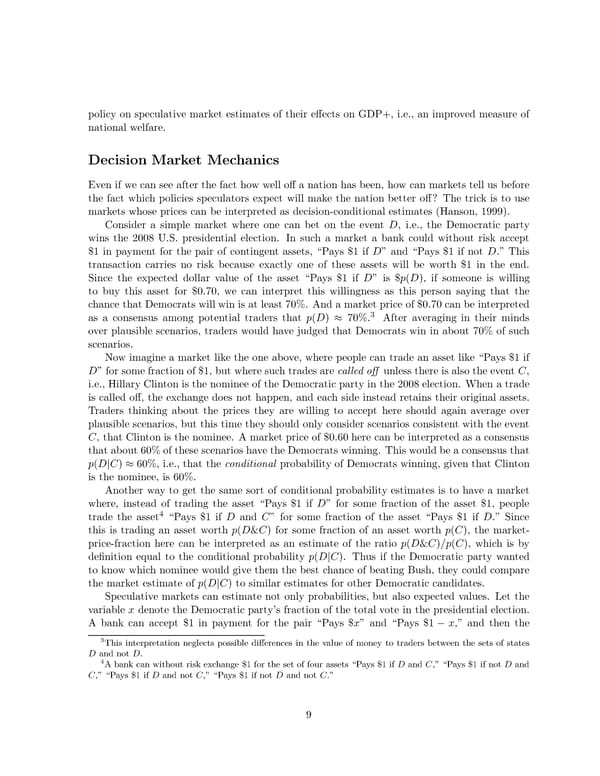policy on speculative market estimates of their effects on GDP+, i.e., an improved measure of national welfare. Decision Market Mechanics Even if we can see after the fact how well off a nation has been, how can markets tell us before the fact which policies speculators expect will make the nation better off? The trick is to use markets whose prices can be interpreted as decision-conditional estimates (Hanson, 1999). Consider a simple market where one can bet on the event D, i.e., the Democratic party wins the 2008 U.S. presidential election. In such a market a bank could without risk accept $1 in payment for the pair of contingent assets, “Pays $1 if D” and “Pays $1 if not D.” This transaction carries no risk because exactly one of these assets will be worth $1 in the end. Since the expected dollar value of the asset “Pays $1 if D” is $p(D), if someone is willing to buy this asset for $0.70, we can interpret this willingness as this person saying that the chance that Democrats will win is at least 70%. And a market price of $0.70 can be interpreted as a consensus among potential traders that p(D) ≈ 70%.3 After averaging in their minds over plausible scenarios, traders would have judged that Democrats win in about 70% of such scenarios. Nowimagine a market like the one above, where people can trade an asset like “Pays $1 if D”for somefraction of $1, but where such trades are called off unless there is also the event C, i.e., Hillary Clinton is the nominee of the Democratic party in the 2008 election. When a trade is called off, the exchange does not happen, and each side instead retains their original assets. Traders thinking about the prices they are willing to accept here should again average over plausible scenarios, but this time they should only consider scenarios consistent with the event C, that Clinton is the nominee. A market price of $0.60 here can be interpreted as a consensus that about 60% of these scenarios have the Democrats winning. This would be a consensus that p(D|C) ≈ 60%, i.e., that the conditional probability of Democrats winning, given that Clinton is the nominee, is 60%. Another way to get the same sort of conditional probability estimates is to have a market where, instead of trading the asset “Pays $1 if D” for some fraction of the asset $1, people trade the asset4 “Pays $1 if D and C” for some fraction of the asset “Pays $1 if D.” Since this is trading an asset worth p(D&C) for some fraction of an asset worth p(C), the market- price-fraction here can be interpreted as an estimate of the ratio p(D&C)=p(C), which is by definition equal to the conditional probability p(D|C). Thus if the Democratic party wanted to know which nominee would give them the best chance of beating Bush, they could compare the market estimate of p(D|C) to similar estimates for other Democratic candidates. Speculative markets can estimate not only probabilities, but also expected values. Let the variable x denote the Democratic party’s fraction of the total vote in the presidential election. A bank can accept $1 in payment for the pair “Pays $x” and “Pays $1 − x,” and then the 3This interpretation neglects possible differences in the value of money to traders between the sets of states Dandnot D. 4A bank can without risk exchange $1 for the set of four assets “Pays $1 if D and C,” “Pays $1 if not D and C,” “Pays $1 if D and not C,” “Pays $1 if not D and not C.” 9
 Shall We Vote on Values, But Bet on Beliefs? Page 10 Page 12
Shall We Vote on Values, But Bet on Beliefs? Page 10 Page 12